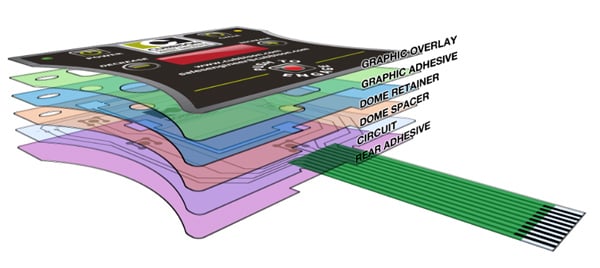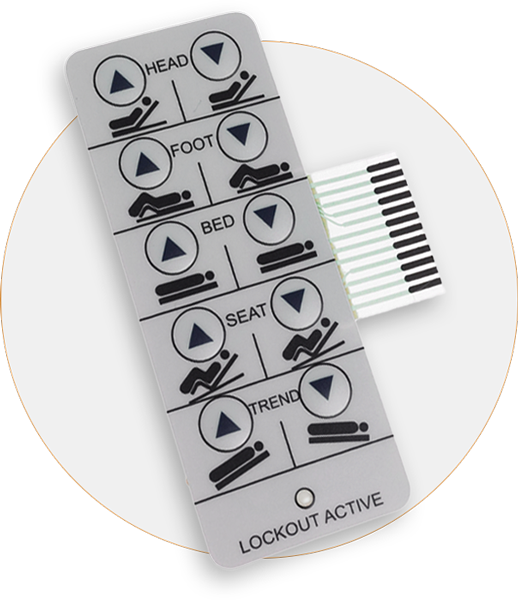Why Membrane Layer Switches Over Are Crucial for Sturdy Control Systems
Membrane switches play a pivotal duty in guaranteeing the durability and reliability of control systems throughout numerous markets. Their distinct construction enables them to endure challenging ecological aspects such as humidity, temperature extremes, and physical wear. This resilience not just prolongs the life expectancy of the systems they offer but additionally lessens maintenance demands. As we discover the complex benefits of membrane layer switches, it comes to be obvious that their relevance goes beyond mere capability, influencing user experience and functional efficiency. What more ramifications do these qualities hold for the future of control system layout?
Summary of Membrane Layer Buttons
Membrane switches are flexible and trustworthy elements commonly utilized in various electronic control systems. The graphic overlay provides both practical and aesthetic design, while the spacer layer ensures that the switches are activated only when pressed.
Membrane layer buttons are usually preferred in applications calling for a compact and light-weight style, making them suitable for portable gadgets, medical tools, and industrial machinery. They can be tailored to fulfill details individual needs and can integrate various features such as backlighting, responsive comments, and multiple shades. Membrane switches are immune to dust, moisture, and impurities, making them appropriate for settings where toughness is essential.
Benefits of Toughness
In lots of applications, the resilience of membrane layer switches deals significant benefits that boost their overall efficiency and reliability. These buttons are developed to withstand rough settings, making them suitable for use sought after problems such as high humidity, severe temperatures, and exposure to chemicals. Their durable building helps to avoid damage from physical influence, making certain durable performance and minimizing the need for frequent substitutes.
Furthermore, membrane layer switches are immune to deterioration, which is essential in applications where frequent communication occurs. This toughness translates to decrease upkeep expenses, as companies take advantage of minimized downtime and less service disturbances. In addition, the encapsulated design of membrane switches over protects interior components from dust and moisture access, more adding to their lifespan.
One more advantage is their capability to preserve consistent efficiency with time. With a high resistance for mechanical stress, these buttons maintain their responsive responses and electrical integrity, making sure individual satisfaction. Ultimately, the sturdiness of membrane layer switches over not just improves operational effectiveness however likewise promotes self-confidence in their dependability, making them a favored option for control systems across various sectors.
Applications in Numerous Industries
Resilient control systems employing membrane buttons locate considerable applications across a variety of markets, each gaining from the distinct characteristics these switches offer. In the medical sector, membrane layer buttons are vital for gadgets such as patient screens and diagnostic tools, where integrity and ease of cleaning are critical. Their resistance to moisture and impurities guarantees they maintain capability in sterile environments.
The automobile market leverages membrane layer switches for dashboard controls and infomercial systems, where they give sleek, low-profile user interfaces that improve user experience. These buttons are likewise developed to withstand extreme conditions, consisting of exposure to severe temperature levels and vibrations.
In commercial settings, membrane layer switches are typically utilized in equipment control panels, supplying tactile responses and longevity essential for high-usage applications. Their capability to stand up to chemicals makes them appropriate for making environments where spills and impurities are regular.

Customer electronic devices, such as kitchen home appliances and remotes, additionally utilize membrane buttons for their versatility and cost-effectiveness. In general, the versatility and robust nature of membrane changes make them indispensable throughout various fields, ensuring reliable operation and durability basics in control systems.
Style and Visual Appeal
While functionality is vital, the style and aesthetic appeal of control systems geared up with membrane layer switches play a critical duty in individual engagement and total experience (membrane switch). The aesthetic layout of these buttons can dramatically affect individual understanding and interaction. A properly designed membrane button improves the good looks of the gadget, making it much more attractive to customers and promoting a link in between the individual and the product
Membrane layer switches supply a good deal of flexibility in layout, permitting makers to customize graphics, colors, and textures to line up with brand name identity and item aesthetic appeals. The use of lively colors and distinctive patterns can draw attention, while tactile responses can reinforce the user's interaction with the gadget. Furthermore, the ability to integrate LED signs and backlighting right into the membrane layer switch design supplies both practical and visual advantages, boosting visibility and usability in different settings.

Enhancing Individual Experience

Moreover, membrane layer switches can be personalized to integrate graphical interfaces, enhancing use by offering information in a clear and intuitive manner (membrane switch). This modification can consist of icons, tags, and color coding that overview individuals click for more through complex functionalities with convenience. Additionally, their versatility permits assimilation in different environments, guaranteeing regular performance whether in industrial equipment or consumer electronic devices
The longevity of membrane buttons additionally plays a critical duty in customer experience. By enduring extreme conditions and expanded use, these buttons decrease the probability of system failures, therefore promoting integrity and user confidence. Eventually, the strategic use membrane layer changes not just elevates functionality but likewise significantly enhances user interaction with control systems, making them a vital element in modern style.
Verdict
